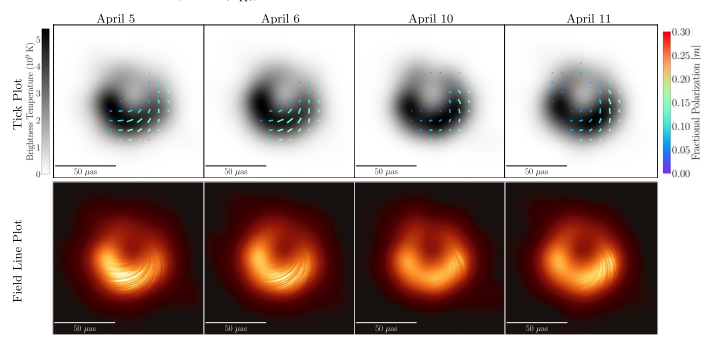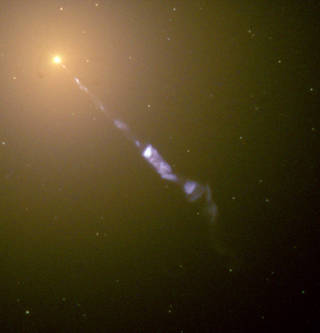The first ever image of a black hole's swirling magnetic field is released
The Event Horizon Telescope has taken a new image of black hole M87, revealing its magnetic field
EHT Collaboration
A few years ago, the world saw the first image of a black hole thanks to the Event Horizon Telescope.
Although black holes by definition don’t emit light, we can see the shadows they cast on all the hot plasma swirling around them. A black hole's shadow is a bit bigger than its event horizon, the region from which nothing (not even light, the fastest thing in the universe) can escape. The area around this shadow is where we see matter either falling into the black hole or getting ejected out in the form of a large jet. That area around a black hole's shadow is full of information, but hard to see — it's quite small in the context of outer space, and extremely far away.
Luckily, the Event Horizon Telescope has figured out how to take images of these shadows and all the interesting stuff going on around them. In 2019, they released the first ever image of a black hole, a photo of the supermassive black hole at the center of Messier 87, one of our large galactic neighbors. This black hole is a whopping 6.5 billion times the mass of our Sun (almost 1500 times the size of our Milky Way’s central black hole, Sgr A*), and it’s emitting a jet of matter bigger than the entire M87 galaxy.
(You might be wondering—why are we looking at a black hole in a far away galaxy when we have one right here at home in the Milky Way? As mentioned, Sgr A* is much much smaller than M87’s black hole. Since it’s so small, it changes much faster, making it hard to get a clear image. Think of taking a photo of a parked car versus one driving on the highway.)
In order to get that historic photo of M87, the EHT team, a collaboration of hundreds of scientists, connected many radio telescopes across the world to effectively make a telescope the size of Earth (a technique called “Very Long Baseline Interferometry”). This powerful array of telescopes has such high resolution that it could “read a newspaper in New York from a sidewalk cafe in Paris” and “measure the length of a credit card on the surface of the Moon.” These telescopes collected petabytes of data (the equivalent of almost 15,000 iPhone hard drives worth of information) that had to be combined by supercomputers to make the final image we see. That first image added incredible evidence to Einstein’s famous theory of relativity, which predicted what the shadow of a black hole would look like, and opened the door for scientists to learn more about the mysteries of black holes.
Although their schedule for new observations this year was delayed due to COVID-19, scientists in the EHT collaboration were able to take a deeper dive into the data they had already recorded, this time looking for polarized light. Light is made up of electromagnetic waves, which can oscillate in different directions — up and down, left and right, or some combination of the two. Polarized light has all its waves oscillating in the same direction. Different things can cause light to become polarized, like certain filters that only let through one orientation of light (for example, some sunglasses). Magnetic fields can also lead to polarized light — as electrons spiral around magnetic field lines, they release polarized light in a process known as synchrotron radiation. Based on what direction of polarization we observe, we can figure out the direction of the black hole’s magnetic field. This is what the EHT team has done, adding lines that show the direction of polarization to their image of M87.

Two ways of visualizing the new polarized light observations from the EHT. The top figures show "tick plots" for each observation of M87, where each small tick represents how polarized the light is at that part of the image. A longer tick means the light is more polarized. The bottom figures show the magnetic field lines superimposed on top of the black hole image.
But why do we care so much about this black hole and if it has a magnetic field? By comparing these new polarization measurements to computer models, astronomers can try to understand how the magnetic fields and plasma around the black hole could create M87’s huge jet. As mentioned before, this region around the black hole’s shadow is where all the interesting stuff is happening — matter is accreting into the black hole, but it’s also flowing outwards into the jet.

The elliptical galaxy M87 with its strikingly huge jet coming from the central black hole as imaged by the Hubble Space Telescope.
NASA, ESA and the Hubble Heritage Team (STScI/AURA)
More observations are needed to get the whole picture of what’s going on, but so far the team has found the black hole has a magnetic field 10,000 to 300,000 times greater than Earth’s. Models with strong magnetic fields explain the data better, since these strong fields could keep some of the gas from falling into the black hole, therefore allowing it to be launched out in the jet. There is still a lot to figure out about exactly how a region that small makes a jet that large, but thankfully the EHT collaboration has big plans for the future. In the coming years, they’re adding more telescopes and new technology to create the next-generation EHT (ngEHT), which will make additional observations of the fascinating black hole in M87, and even capture images of other targets like our very own Sgr A*.